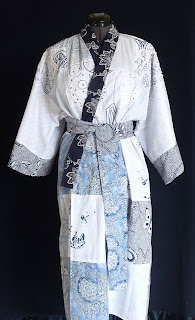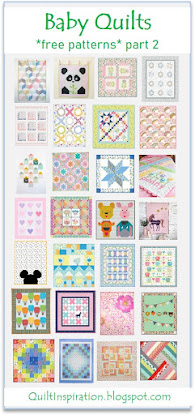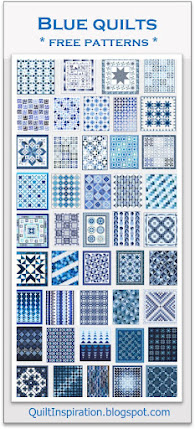We think the construction and design of Hawaiian quilts is fascinating.... do you like them too? Today we're bringing back one of our favorite Quilt Inspiration posts. These gorgeous quilts are also in keeping with next week's theme of exotic flower quilts. Come along with us on an island adventure !
Long ago, the Hawaiians learned to make their own cloth, called "tapa" by pounding Mulberry tree bark and fibers tightly together. They colored it with natural dyes from their environment and sewed it into bed coverings, using thin, twisted vines and needles made from fish or bird bones. When the 19th century missionaries brought cotton to the Hawaiians, they transferred their skills onto cloth, using large pieces of fabric, instead of small patchwork squares. Today, Hawaiian quilts are still made in the wholecloth style, with vibrant curved patterns painstakingly hand-appliqued with thousands of tiny stitches. The applique fabric is usually folded into fourths, then cut into intricate shapes, as one would cut snowflakes or conjoined dolls from paper.
Royal Symbols With Border, by
Deborah Kakalia

Every June 11, Hawaii celebrates King Kamehameha Day, in commemoration of the esteemed 19th century monarch who united the islands under one government. Here is a quilt by famed artist Deborah Kakalia, which honors past Hawaiian Royalty. There are four crowns which pay tribute to the monarchy, along with four "kahili", the feathered scepters or staff carried by the kings and queens as they walked in procession. This is a regal and elegant quilt, which the artist presented as a gift to
The Bishop Museum in Honolulu.
Nanahonua (Angel's Trumpet Quilt), by
Deborah Kakalia

Another magnificent work of art from Deborah Kakalia is her Nanahonua quilt, or Angel's Trumpet quilt. The Angel's Trumpet tree produces large, colorful, bell-shaped flowers, reminiscent of celestial trumpets. Nanahonua means "earth-gazing", an apt name since the Hawaiians learned to smoke the Angel's Trumpet leaves as hallucinogens. However, one would have to be perfectly sober to create a quilt this intricate and precise, which almost looks like a beautiful lace handkerchief.
For Kulaniakea, by
Nalani Goard

Nalani Goard, who is the granddaughter of Deborah Kakalia, has designed and constructed many lovely quilts, so this fabulous talent obviously runs in the family. Here is a quilt that Nalani created for her brother, Kulaniakea. She writes that he wanted a design of pineapples and guava for hospitality and strength. Nalani's work is an excellent example of large, leafy quilt patterns which reflect the lush vegetation of Hawaii. Nalani also offers design instruction, quilt kits, and finished quilts at her
Hawaiian Quilting website.
Na Ulu O' Hawaii (Breadfruit Quilt), by
Nancy Lee Chong, at
Pacific Rim Quilt Company

From the Pacifc Rim Quilt Company comes the pattern for the esteemed and venerable breadfruit. The breadfruit tree is a symbol of abundance and an ancient legend tells us that those who make Ulu their first quilt will always enjoy prosperity. Above, the round shapes of the breadfruit form a "ring of plenty" around the star created by the intersecting branches of the tree. PRQC offers a wide variety of Hawaiian quilt patterns, kits, fabrics,
videos, and notions.
Breadfruit(Ulu), Wall Quilt, 18 x 18

Tiki Master, which sells all things Hawaiian, recently featured this arresting dark green and white wall hanging of the
breadfruit pattern. The rounded breadfruit here are easily seen here at the base of the outer leaves of the tree. It is said that one day in the 19th century, some Hawaiian quilters were outside, working on pieced patchwork, when one of them noticed that the sun behind a breadfruit tree was casting a fascinating shadow on the grass. The shadow of the breadfruit tree interested them so much more than patchwork, that they immediately went to work on creating a wholecloth image of that shadow. Thus, the first truly Hawaiian quilt was born.
Hawaiian Applique 2008 by
Kerry Marksbury

Here's a quilt which is as lushly green and refreshing as a Kauai rainforest. This four block quilt is a variation on the traditional Hawaiian wholecloth quilt. Kerry Marksbury has created a fabulous quilt with blocks depicting the auspicious Ulu, dignified sea turtles, pineapple plants, and tropical blossoms, possibly Hibiscus. The lighter green scalloped middle border provides eye-catching detail to the blue/green batik outer border and block motifs. Notice the innermost aqua border, which provides a fanciful grasslike fringe effect to complement the emphasis on flora and fauna. For more fascinating quilts, please see
Kerry's Quilting.
Lava Flow by
Cydney Brooks

Using custom dyed Ultra-Sateen fabric from Jeanette Viviano at
Jeanette's Fabric to Dye For, Cydney Brooks creates a tribute to another of Hawaii's natural wonders, the volcanoes of the Big Island. Jeanette and Cydney collaborated on the fabric colors, and Janet Fogg quilted this vibrantly colorful work. The orange and gold glowing embers and flickering flames of the center medallion give rise to the swirling, meandering trails of lava as they make their way down the mountainside to the ocean. This is an exquisite use of contrasting colors, as the orange applique seems to pulsate with movement against the serene aqua background.
Hibiscus Fire by
Carol Kamaile

A gorgeous quilt inspired by the islands' beloved Hisbiscus flowers is Carol Kamaile's "Hibiscus Fire". Carol is a well known quilt artist, whose creations were displayed at the
San Jose, California, Museum of Quilts and Textiles in August, 2010. Native to Hawaii, the hibiscus plant comprises thousands of varieties, in all flower colors from delicate white, through bright pink, pastel pink, coral, yellow, and red. It is interesting that Carol has made the center of her medallion golden yellow, as the yellow Hibiscus is the State Flower of Hawaii.
Hawaiian Yams by
Hawaiian Style Quilts

Allen and Ipo Camara are the owners of
Hawaiian Style Quilts, which provides magnificent custom quilts, tailor made to the customer's request. On this elegant gray and white large bedspread, with its artful matching accent pillows, you can see a clear example of the traditional outline stitching done on Hawaiian quilts. The quilting pattern carefully follows the outline of the applique shapes, starting out as parallel lines and turning into concentric rings, until all the background is filled up. Also known as "echo quilting", outline stitching helps give Hawaiian quilts their lively sense of motion and energy.
Books: For more fascinating patterns, ideas, and instructions, please see the following books:
Hawaiian Applique by Vicky Fleming, or
Hawaiian Quilting: Instructions and Full Size Patterns for 20 Blocks, by Elizabeth Root.











































 by Joen Wolfrom, we can see that "indigo" is a very dark shade of true blue (blue plus black) while "scarlet" is a deep shade of orange (orange plus black). These hues are not complementary, but we think they are beautiful in these dark shades. The navy blue is so dark that it "reads" as a neutral; in the Rothko painting it looks black. Perhaps that's one key to the success of this scheme.
by Joen Wolfrom, we can see that "indigo" is a very dark shade of true blue (blue plus black) while "scarlet" is a deep shade of orange (orange plus black). These hues are not complementary, but we think they are beautiful in these dark shades. The navy blue is so dark that it "reads" as a neutral; in the Rothko painting it looks black. Perhaps that's one key to the success of this scheme.


















